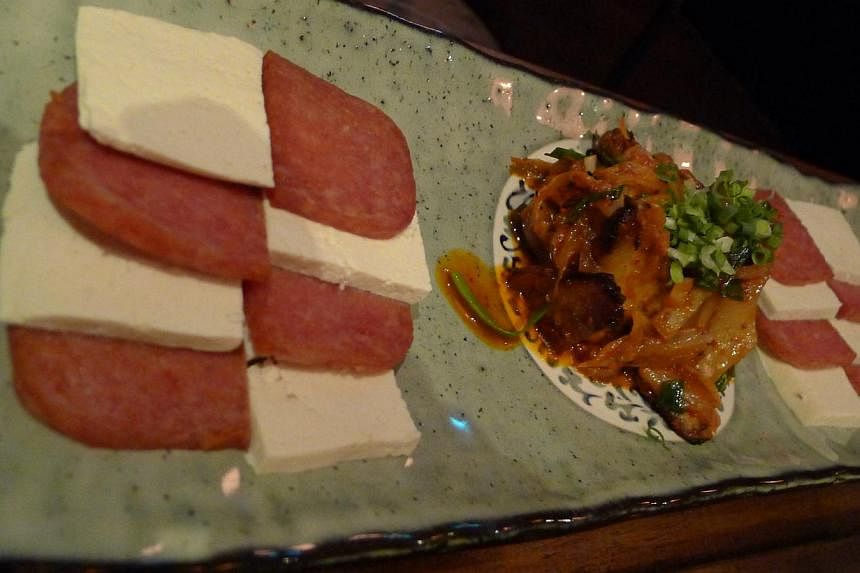Like many other cuisines, Korean food has been getting an update - especially in Seoul, where young chefs who return home after stints abroad are opening restaurants offering modern takes on traditional dishes.
The trend has now arrived in Singapore; a sign perhaps of a maturing market for Korean food here as restaurateurs and diners are ready to move beyond the bulgogi, bibimbap and fried chicken commonly associated with the country's cuisine.
Joo, which opened in the Bugis area last November, is one of those boldly venturing into this new territory. While ostensibly a makgeolli bar - makgeolli is a popular alcoholic beverage in Korea made from fermented grain - it also offers a full menu of food that is a mix of Korean and Western cooking.
And some of the offerings turn out really good, such as Warm Kimchi With Tofu And Spam ($14). It consists of a spicy stir-fry of kimchi, onion, scallion and pork belly served with slices of firm tofu and luncheon meat. You sandwich the kimchi between a slice each of tofu and Spam. Eaten together, the bland tofu smoothens out the strong flavours of the fermented cabbage without robbing it of its character. The Spam, on the other hand, adds a savoury goodness that enriches the flavours.
But in instances where the spices get too diluted, however, the dishes fail to work.
An example is the Calamari With Garlic Bread Crumbs ($18), which comes with a gochujang mayonnaise dip. Gochujang is a Korean red pepper paste, a pungent fermented condiment made from chillies, soya beans and salt that you stir into dishes such as bibimbap.
Here, it is used so sparingly that its Korean character fails to emerge and the deep-fried calamari could just as well have been served with any generic store-bought spiced mayonnaise. Also, the squid is sliced too thin and becomes dry as a result, which reduces the dish's appeal.
The Seafood Gochujang Risotto ($24), too, could do with a bigger dollop of the spicy paste. The gooey rice, studded with shrimp, mussels, clams and squid, is tasty enough, but the gochujang is too meek to suggest a Korean connection.
The same problem befalls the Kimchi Chicken Potpie ($12), which could otherwise have been an interesting idea of a Western chicken pie getting a boost from kimchi bechamel. But the taste of kimchi is elusive and does not make an impact.
The most Korean dish for me is the Joo Bossam ($28). It stays very close to the traditional recipe, where slices of boiled pork belly are served with a variety of condiments, such as kimchi, pickled radish and spicy sauces, and eaten together wrapped in a Napa cabbage leaf.
Here, the dish is simplified to just pork, kimchi and pickled cabbage, which is cut too small to wrap anything. But it is delicious, especially the Hungarian Mangalitsa pork, which has so much more flavour than the meat usually sold here. It is rather fat, so the kimchi and cabbage provide a strong dose of acidity to cut the heaviness.
Pork lovers can also try the Grilled Mangalitsa Belly ($22), where slices of the marinated grilled meat are served with a spicy chive salad. It is good, but ordering two pork belly dishes turns out to be too much. Such fatty meat, I realise, is best enjoyed in moderation.
So it is just as well that the restaurant is not serving dessert at the moment. That will have to wait for another visit down the road, when the restaurant fixes its staffing issues.
In the meantime, the chef can perhaps tweak some of his recipes for a stronger Korean identity. Fusion cooking may often result in a dilution of traditional flavours, but it should not be at the expense of character.
Follow Wong Ah Yoke on Twitter @STahyoke
SundayLife! paid for its meals at the eateries reviewed here.



